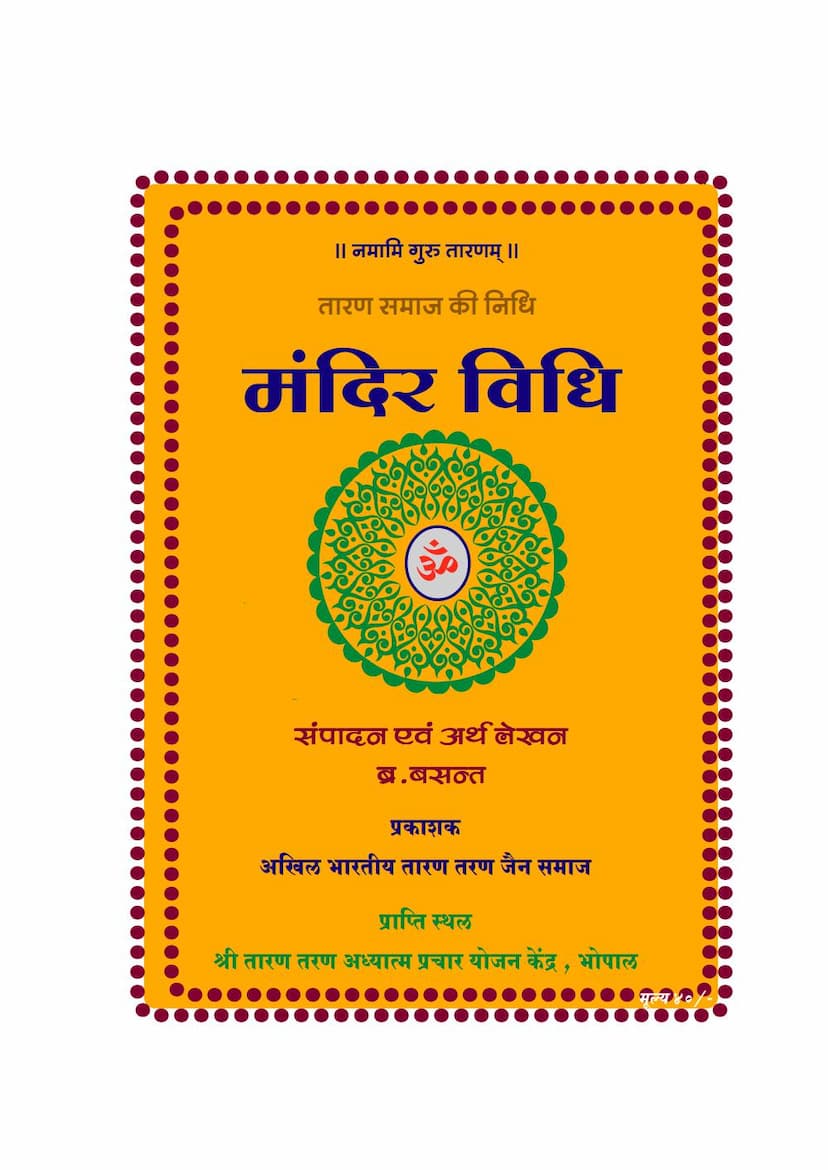Mandir Vidhi
Added to library: September 2, 2025

Summary
Here's a comprehensive summary of the Jain text "Mandir Vidhi" by Basant Brahmachari, based on the provided text:
Mandir Vidhi: A Guide to Jain Temple Rituals and Spiritual Practice
"Mandir Vidhi" (Temple Rituals) by Brahmachari Basant, published by Akhil Bharatiya Taran Taran Jain Samaj, is a detailed guide outlining the prescribed practices and ceremonies within the Taran Taran Jain tradition. The book serves as a comprehensive resource for understanding and performing temple rituals, spiritual contemplation, and upholding Jain principles.
Core Philosophy and Purpose:
The text emphasizes that true worship (पूजा) lies not in outward rituals alone but in cultivating virtues like knowledge, right conduct, and faith (सम्यग्दर्शन, सम्यग्ज्ञान, सम्यक्चारित्र). The ultimate aim is to experience one's own pure soul (शुद्धात्म देव) and embody the qualities of the Tirthankaras and the Guru. The book stresses the importance of internal spiritual practice over external ostentation.
Key Sections and Their Significance:
The "Mandir Vidhi" is structured into various sections, each addressing a specific aspect of Jain worship and spiritual development. The table of contents reveals a rich collection of devotional hymns, philosophical expositions, and practical guidance.
- Devotional Hymns and Prayers (फूलना, गाथा, स्तोत्र): The book contains numerous devotional pieces like "Shri Malarohan Ji," "Shri Pandit Puja Ji," "Shri Kamal Battiisi Ji," "Shri Dev Dipti Phoolna," "Shri Guru Dipti Gatha," "Shri Dharm Dipti Gatha," and "Swami Taran Deva Phoolna." These hymns are central to expressing devotion to the divine, the guru, and the principles of dharma. They often praise the virtues of the Tirthankaras and the Taran sect's founder, Swami Taran Taran.
- Philosophical Principles: The text delves into core Jain tenets, including the significance of the Daslakshan Dharma (Ten Virtues) and the Solah Karan Bhavna (Sixteen Contemplations). It explains the path to liberation through right faith, right knowledge, and right conduct.
- Temple Rituals and Procedures: A significant portion of the book is dedicated to the practicalities of temple rituals. This includes:
- Brihad (Grand) and Laghu (Simple) Mandir Vidhi: The book outlines two forms of temple rituals, indicating their purpose and application on different occasions.
- Starting and Sequence of Rituals: Clear guidance is provided on how to commence and proceed through the various ritualistic steps.
- Specific Rituals: Detailed explanations are given for various ritualistic components like Aarti, Jinwani Stuti, Prabhathi, and various other devotional songs and chants.
- Daily and Occasional Practices: The text suggests when and how to perform different rituals, from daily observances to special occasions like festivals, temple inaugurations, and annual fairs.
- The Role of the Taran Taran Community: The book highlights the historical and ongoing tradition of performing "Mandir Vidhi" within the Taran Taran community for over 540 years. It underscores the importance of this practice for spiritual and social awakening, as well as for the propagation of dharma.
- Standardization and Refinement: A substantial portion of the introduction discusses the need for standardizing the "Mandir Vidhi." It explains that over time, variations had crept into its practice across different locations due to the absence of a unified text. The compilation and editing process involved studying numerous manuscripts and printed copies to establish a consistent and accurate version, prioritizing the core tenets and dignity of the Taran Panth.
- Interpretation and Explanation: The inclusion of explanations (अर्थ सहित) for the hymns and verses makes the text accessible to a wider audience, ensuring the understanding and internalization of the spiritual message. The Q&A section (जिज्ञासा समाधान) addresses common queries and clarifies potential ambiguities.
- Guidance on Conduct: The text also includes a section on "Aasadan Dosh" (Prohibitable Actions), outlining specific conduct to be avoided within the temple premises to maintain sanctity and respect.
Key Aspects of the Compilation:
The author, Brahmachari Basant, undertook extensive research to compile this work, referencing 45 different texts, including 10 ancient handwritten manuscripts. The goal was to unify the practice of "Mandir Vidhi" across all Taran Taran Jain communities, ensuring accuracy and adherence to the tradition. The text is presented in a manner that aims to be engaging and inspiring for all age groups, encouraging participation and a deeper connection with the rituals.
Conclusion:
"Mandir Vidhi" is presented as a vital legacy of the Taran Taran community, embodying a rich tradition of spiritual devotion and philosophical understanding. It serves as a practical and insightful guide for adherents, fostering a deeper connection with Jainism and guiding them on the path of self-realization and liberation. The emphasis on both the inner essence of worship and the prescribed ritualistic framework makes it a valuable text for the Taran Taran Jain Samaj.